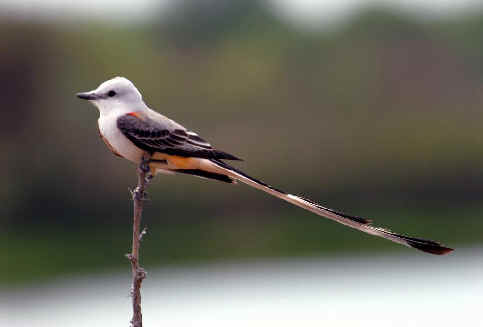
E-mail: font@focusonnature.com
Phone: Toll-free in USA 1-888-721-3555
or 302/529-1876
 |
PO
Box 9021, Wilmington, DE 19809, USA E-mail: font@focusonnature.com Phone: Toll-free in USA 1-888-721-3555 or 302/529-1876 |
THE FOCUS ON NATURE TOUR IN TEXAS
MAY 2010
"In a big state where nature abounded: birds, mammals, butterflies, & wildflowers"

The Scissor-tailed Flycatcher
was one of the birds that was especially enjoyed
during the May 2010 FONT tour in south-central Texas.
Links:
Birds & Other Wildlife during our Texas Tour in May 2010
A Complete List of Texas Birds
Texas Birds during FONT tours (with some photos)
List
of Texas Mammals (with some photos)
List
of Texas Butterflies (with some photos)
Plants
of the Desert & Some Nearby Habitats
(with some photos)
Upcoming FONT Birding & Nature Tours in Texas
The following narrative of the FONT May 2010
tour in Texas was
written by Armas Hill, the tour leader:
The largest of the 48 contiguous states, Texas is a land of superlatives. And for birding that is especially true. Texas has the most bird species of any US state, with over 630. New additions have been added just about annually, mostly vagrants from Mexico.
Texas is so much a place for birding that in the early days of the Peterson Bird Field Guides, there was the guide to the East, the guide to the West, and the guide to Texas. That was due in part to East meeting West in Texas (more will be noted about that later in this narrative), but there was certainly enough bird-wise in the state to fill the book!
In Texas, during our
May 2010 tour, it was not just the
number of species, but the large numbers of some of
the birds that was at times so noticeable. There were so many birds.
The state bird, the Mockingbird, was heard singing, again & again
& again.
Cardinals seemed to be everywhere, both seen and heard in many of the
habitats that we visited.
And more than once, when we stopped, we couldn't help but notice how many Dickcissels
were calling in the fields. So many.
Not only were there large numbers of birds, also there were tremendously large numbers of butterflies. And it seemed that wildflowers could not have been more plentiful. There were so many in bloom, and a variety.
In one woods that we visited, there were thousands and thousands of caterpillars. They were falling to the ground off trees, big and small. Many of the trees in that riparian woods were denuded, with trees, big and small, leafless. The caterpillars were "everywhere" on the ground.
As to the plethora of wildflowers and butterflies, we were told that earlier in the spring, before our tour, there had been a good spell of rain, after a long spell of drought, about 3 years. Other than the one denuded forest, there was greenery as we traveled about, along with the multi-colored fields of so many flowers.
Also in a very large number,
during our May '09 Texas Tour, in addition to the flowers, butterflies, and
birds, there was a mammal.
At dusk, at two locations, literally millions of Mexican Free-tailed Bats
were seen, flying out into the evening sky. They were in incredible swarms.
I noted that Texas has more bird species than any other state. It also has more bat species. Of the 45 species of bats in North America, 32 occur in Texas. And as to the number of individual bats, no other state comes close! As there are a number of places in Texas was "incredible swarms" of the Mexican Free-tailed Bats. And what's also "incredible" about them is that spread out during the night, high in the sky, over much of the expansive land called Texas.
Yes, Texas is a land of superlatives. And it is a great place for a birding and nature tour, as we did for about a week in early May 2010.
From the Gulf Coast west, there's an array of various habitats in Texas. These include pine and hardwood forests, prairies, deserts, hills and mountains, lakes and ponds, and farm and ranch lands. Such diversity assures the big variety of birds that occur in Texas.
During our May
1-9, 2010 tour,
we did not cover Texas from one end to the other, but rather we concentrated in
south-central Texas, from the Gulf Coast west to the
"Hill
Country" of the Edwards Plateau. In just that one region of the
state, there were nearly all of the habitats just noted (except for
mountains).
And in that region of south-central Texas, especially near the city of Austin,
for us, and our birding, East did meet West.
From that city east, birds included: Ruby-throated Hummingbird, Blue Jay, and
Red-bellied Woodpecker.
From that city west, birds included: Black-chinned Hummingbird, Western
Scrub Jay, and Golden-fronted Woodpecker.
And to the west and north of Austin, 2 of the truly avian stars of the Texas show occur: the Golden-cheeked Warbler and the Black-capped Vireo, with the warbler nesting nowhere else in the world other than in Texas, and the vireo nearly so.
About an hour east of Austin, we visited a pine forest that's about 200 miles west of any other such habitat. For that reason, the place is called the "Lost Pines". Whether or not lost, the place is good to find. In it, we encountered nesting Pine Warblers, Northern Parulas, singing Summer Tanagers and Carolina Wrens, much as one would hear somewhere in the pines of the Southeast US. After dark, Chuck-will's-widows called, much as they would in a Southeast US pine forest.
Along the Gulf Coast, a nice call we heard, late in the day, was that of the Black Rail. It may have wintered in that marshy area, or it may have been passing through on its way to nest further north.
Numerous birds migrate north along the Texas seacoast in the spring. We enjoyed, as have in the past, such birds during their journey as warblers, flycatchers, and orioles. The Blackburnian and Black-throated Green Warblers were especially nice to see. An Olive-sided Flycatcher was a good find. And one small tree was filled with both colorful Baltimore and Orchard Orioles.
All of those birds would continue north. But some birds that we liked to see had migrated to Texas from their winter haunts.
Particularly notable among them were the many Scissor-tailed Flycatchers we saw. But no matter how many of them we saw, they continued to be good to see - every time.
And there were the numerous Dickcissels. Maybe some of them were to continue north, but others certainly seemed ready to stay, as males were constantly proclaiming their territories.
Onomatopoetically speaking,
there were not only the Dickcissels. Also there were the Northern
Bobwhite, the Eastern Wood Pewee, and the Killdeer.
They were "onomatopoetically speaking" as they all were saying their
names. At one time, all 4 of those species, were heard at once.
At other times, other onomatopoetic birds that we heard were the Eastern
Phoebe, the Pauraque, and the already-mentioned Chuck-will's-widow.
Along the Texas Gulf
Coast, we
had a good day with many coastal birds, including numerous shorebirds,
long-legged waders, and a half-dozen species of terns and skimmers
at once.
Among the long-legged waders, the Reddish Egrets were particularly worth
watching for a while. We observed both the dark and white morphs of that species
doing their acrobatic antics as they danced about.
Among the shorebirds, we saw a bird that's rare in Texas, the Piping Plover.
The total North American population of that species is low, around 5,000 or so.
Along the Texas coast, there are not many to see, as we did.
A bird that is not rare in Texas
is the Cave Swallow. Not that many years ago, it was said to be in the
state in low numbers, mostly in limestone caves.
Now, the species is far from rare in Texas. It is abundant, notably at highway
overpasses, or closer to the ground at culverts by, for example, farm ponds. We
saw many Cave Swallows during our tour, although the similar Cliff
Swallow, of which we also saw many, is still said to be the most abundant
nesting swallow in Texas.
It's interesting that now, more than previously, after the breeding season,
numbers of Cave Swallows, of the race nesting in Texas, are being found
in the late fall further north in the US, especially in the northeast states.
As just noted, the Cave
and Cliff Swallows are much alike. Other birds that could be referred to
as "similar sibling species" were also noted during our spring '09
Texas tour, such as:
Glossy and White-faced Ibises, Long-billed and Short-billed
Dowitchers, and Boat-tailed and Great-tailed Grackles.
The Boat-tailed Grackle was only seen once, during the tour, along the
Gulf Coast.
The Great-tailed Grackle is yet another species of bird that is
ubiquitous in the state of Texas, where birds overall would be plentiful even
without the grackles - but of course, and especially in the cities and towns,
they do add measurably to the total number!
Bird-wise, we'll end with a
species that's not plentiful in Texas, but is now more common there, as it is
more common now elsewhere in North America, than it was a couple decades ago, the
Bald Eagle.
One morning, as we were driving along a highway near the coast, an adult Bald
Eagle nicely sat for us itself atop a pole.
On the other side of the highway, there was a Northern Crested Caracara,
a bird sometimes referred to as the "Mexican Eagle".
Actually, by the way, it is the more-westerly Golden Eagle that is the
national bird of Mexico, as the Bald Eagle is the national bird of the
United States.
Among the mammals and other
wildlife during the FONT Texas May '10 Tour, in addition to the Mexican
Free-tailed Bats already mentioned, there were: Gray Fox, deer, raccoon,
opossum, and American Alligator and various turtles and
snakes.